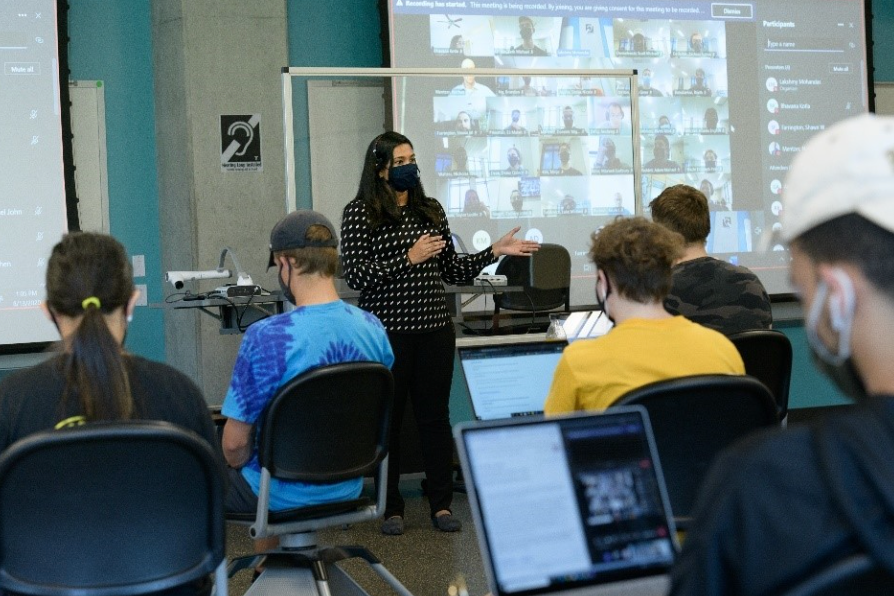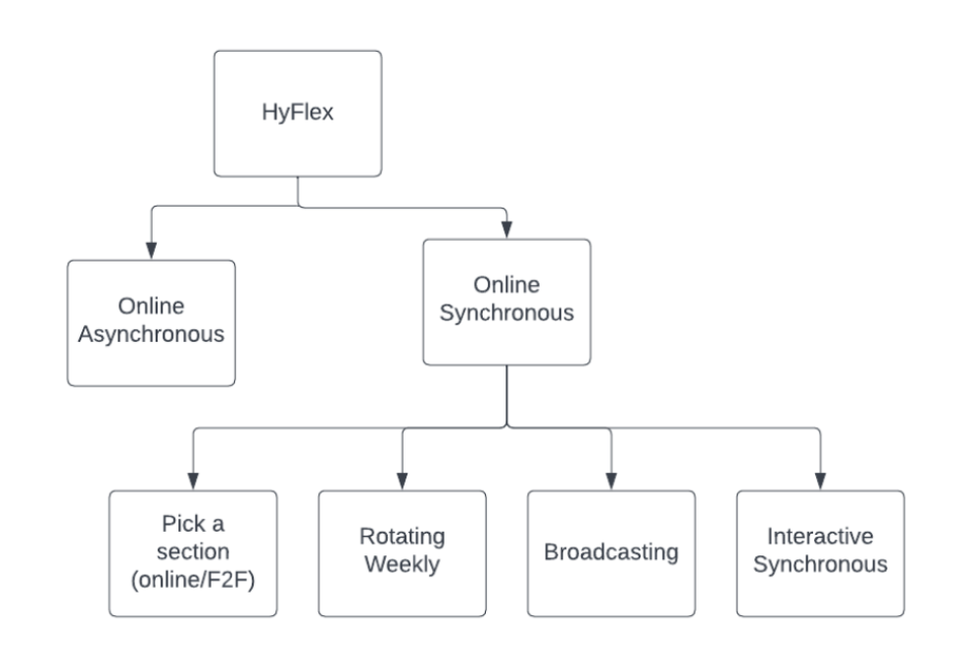
Deeper Dive Topics
What is HyFlex?
HyFlex (Hybrid-Flexible) is an educational model that combines face-to-face and online learning into a single course. This model allows students to choose how they want to attend the course, either in person or remotely, and switch between modes of attendance as needed. In a HyFlex course, students can attend face-to-face sessions, synchronous online sessions, or asynchronous online sessions. They can also switch between modes of attendance based on their preferences, schedules, or other factors that may affect their ability to attend classes in person. The HyFlex model provides flexibility and adaptability to meet the diverse learning needs of students. It allows students to participate in the course in a way that best fits their learning style, location, and other circumstances. The HyFlex model has gained popularity in recent years, especially during the COVID-19 pandemic, as it allows educational institutions to offer courses that accommodate both in-person and remote learners.

HyFlex model provides students with different class participation modes thereby reducing the chance of missing the class and thereby improving students learning outcomes. Beattys’ HyFlex model is built around four main pillars:
- Learner Choice: Provide relevant alternate engagement modes and allow students to choose between daily, weekly, or topic-based participation.
- Equivalency: Provide learning activities in different modes of participation that result in the same learning results.
- Reusability: Use artifacts from learning activities as “learning objects” for all students in each participation mode.
- Accessibility: Equip students with ICT skills and ensure that they have equal access to all means of engagement. (Beatty, 2019, p. 52).
Things to consider for Successful HyFlex implementation
Define your course goals and learning objectives: Determine what you want your students to learn and achieve in the course.
Identify the content and resources needed: Choose the materials and resources that are necessary for students to meet the learning objectives.
Decide on the course structure and participation modes: Determine the modes of participation that you will offer to students, such as face-to-face, synchronous online, or asynchronous online.
Set up the technology infrastructure: Ensure that you have the necessary technology tools and resources to support your chosen participation modes.
Create the learning experiences and assessments: Develop the learning experiences and assessments that align with your course goals and learning objectives. (useful resource for this step- worksheet provided by Beatty 2019 1.4.3).
Communicate with your students: Explain the HyFlex model to your students and clarify how they can participate in the course.
Monitor and adjust: Monitor student progress and adjust the course structure and learning experiences as needed. (Useful resource for this step- worksheet provided by Beatty 2019 Figure 1.4.5).
It’s important to note that implementing a HyFlex model requires careful planning, design, and implementation. It may also require additional training or support for both instructors and students.

The primary variation among HyFlex implementations in various universities centers on the online mode of participation, as illustrated in Figure 1. HyFlex implementation by section selection allows students to choose their preferred mode of participation at the beginning of the semester, either face-to-face or synchronous online, for the remainder of the semester. Another approach to HyFlex allows students to change their mode of participation weekly between online synchronous and face-to-face. In the broadcasting method, the instructor broadcasts the live class to online synchronous students using broadcasting software, enabling them to observe the live class, listen to face-to-face students’ questions, and occasionally pose their own. In Interactive Synchronous HyFlex, students have the freedom to join the course remotely or face-to-face on any given day with complete equity (Mohandas, L. 2022, p.15).
Fostering Equitable Learning in Different Modes of Participation
Use inclusive language: Instructors should use inclusive language that avoids assumptions about students’ backgrounds or experiences.
Provide multiple access points to course content: Instructors should make course content available in multiple formats, such as video lectures, readings, and interactive activities. This can help ensure that students can access the content in the format that works best for them, regardless of their mode of participation.
Foster a sense of community: Instructors should work to foster a sense of community among students in the class, regardless of their mode of participation. This can be achieved through group work, discussions, and other collaborative activities (Mentzer & Mohandas, 2022).
Offer flexible assignments: Instructors should provide assignments that are flexible enough to accommodate different modes of participation. For example, students who are participating in person may complete an in-class presentation, while students who are participating remotely could submit a video presentation instead.
Module Navigation
- Next Module: PoRTAL 2
- Previous Module: Creating Engaging Videos
- Current Topic: Deeper Dive
- Next Topic: XR in Teaching & Learning
Leave Your Feedback
You must be logged in to post a comment.